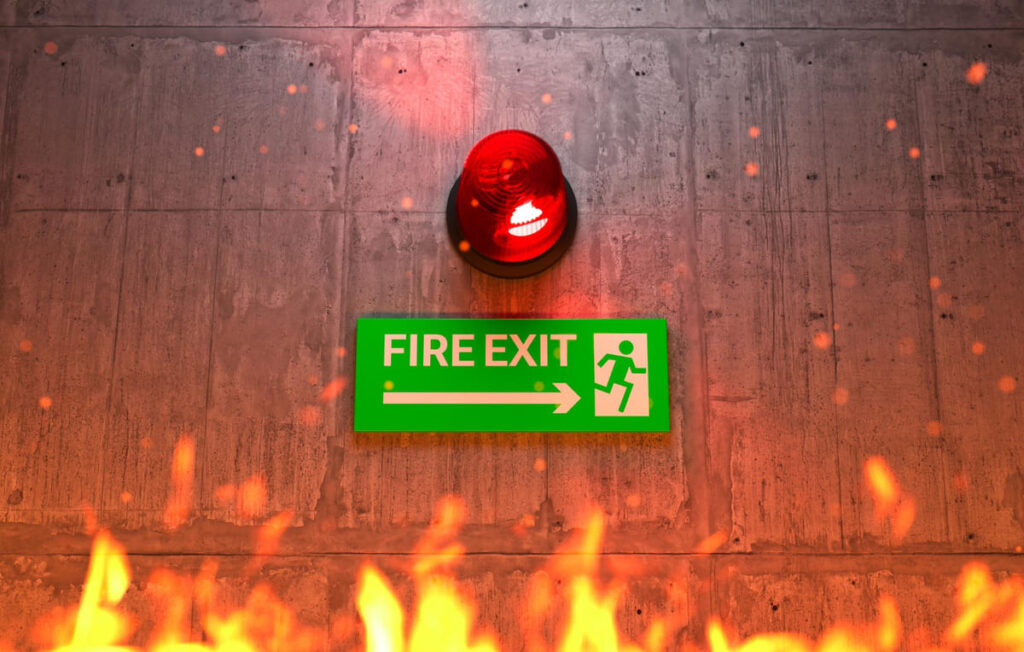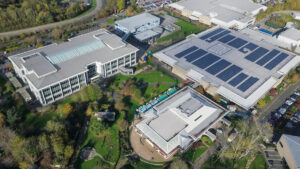Construction sites are dynamic environments with many fire hazards. Sparks from welding, faulty electrical wiring, unattended heaters, and improperly stored flammable materials can all ignite fires. When a fire breaks out on a large construction site, it can halt the project, damage partially built structures, and endanger workers. This article explores common fire-related problems on construction sites and how fire detection sensors are applied as practical solutions. We will discuss the consequences of typical fire hazards and then examine four key applications of fire detection sensors in real-world construction scenarios.
Table of Contents
Problems and Consequences
Fire is a constant risk in construction due to the nature of the work and materials involved. Understanding the common ignition sources and their consequences is crucial for both general construction staff and safety managers. Below are some of the most frequent fire problems on large construction sites and their potential impact on timelines, structural integrity, and worker safety:
1. Hot Work and Welding Sparks
Many construction projects involve hot work such as welding, cutting, brazing, and grinding. These activities produce high-temperature sparks and flames. If proper precautions are not taken, sparks can land on combustible surfaces or debris. For example, welding sparks can ignite wooden formwork, insulation, or roofing materials. The immediate consequence is a fast-spreading fire at the work area. Hot work fires can be particularly dangerous because they often occur near the structure under construction – igniting scaffolds, framework, or protective coverings. A blaze from unchecked hot work can cause serious structural damage to a partially built facility.
In past incidents, something as simple as a misplaced welding torch has led to major blazes that collapse roofs or entire sections of a building. Beyond structural loss, these fires put workers at risk of burns and smoke inhalation. Even if everyone evacuates safely, the project will likely suffer significant delays for repairs and investigations. Overall, uncontrolled hot work can turn a single day’s task into a multi-month rebuilding effort.
2. Electrical Faults and Equipment Malfunctions
Construction sites use extensive temporary electrical installations to power tools, lighting, and machinery. If not properly installed and maintained, electrical faults can occur – for instance, overloaded circuits, damaged cables, or defective equipment. These faults may produce overheating or sparks that ignite surrounding materials. An example is a short-circuit in a temporary power distribution board causing wiring insulation to smolder and catch fire. Electrical fires often start hidden from view (inside wall cavities, cable trays, or equipment casings), so they might smolder and grow before anyone notices.
The consequences can be severe: a smoldering electrical fire after working hours can develop into a large blaze by night. Without early detection, such a fire might engulf critical parts of the structure or spread to materials stored nearby. This not only damages the construction work completed so far (requiring tear-out and redo of electrical and structural installations) but also poses life-threatening hazards if it happens during working hours. Workers can be exposed to electric shock and fire simultaneously. Additionally, the smoke from electrical fires is often toxic (from burning plastics), endangering anyone who inhales it. A significant electrical fire will halt construction until authorities determine the cause and safety of the site, causing downtime and financial loss.
3. Flammable Materials and Fuel Storage
Large projects inevitably involve flammable substances: fuel tanks for generators and vehicles, gas cylinders for cutting torches, paint, solvents, adhesives, insulation foam, and piles of lumber. If these materials are not stored safely, they greatly increase the fire risk. A small ignition source – such as a discarded cigarette, a spark from equipment, or even heat from the sun on a hot day – can set off a fire in a fuel storage area or where flammable chemicals are kept. The immediate consequence is often an intense fire or even an explosion, given the high energy content of fuels and chemicals. Such an event can injure or kill workers in the vicinity and cause extensive damage to nearby structures and equipment.
For example, a flash fire in a fuel storage zone might radiate heat strong enough to warp steel beams or shatter windows of the building under construction. These events also tend to spread rapidly; a fire in one storage container can quickly jump to adjacent containers if not controlled. In addition to the safety threat, a fire fed by flammable stocks can set the project back substantially – important machinery might be destroyed and materials consumed, requiring replacement. The schedule impact includes not only the time to recover those materials and equipment but also potential regulatory shutdowns if safety protocols were violated.
4. Poor Housekeeping and Other Fire Risks
Construction sites generate a lot of combustible debris: wooden pallets, cardboard packaging, sawdust, scrap wood, and paper. Poor housekeeping – allowing trash and debris to accumulate – provides ready tinder for any ignition source. If hot works or electrical sparks contact accumulated waste, a fire can start and use the debris as fuel to grow. Temporary heating devices (like propane or kerosene heaters used in cold weather) are another hazard; they can accidentally ignite nearby combustibles or themselves malfunction. Additionally, many construction sites are exposed after hours, which raises the risk of arson or unauthorized activities. Trespassers might intentionally set a fire or accidentally cause one. Smoking on site against regulations is another potential ignition source.
The consequences of these situations vary, but they can be just as catastrophic. A trash-fueled fire can spread across a floor full of building materials, undermining newly constructed walls or floors. If a blaze weakens structural supports (for example, charring wooden scaffolds or heating steel until it loses strength), parts of the structure can collapse. This not only causes project delays for rebuilding but creates extremely dangerous conditions for firefighters and workers. It’s worth noting that many fires on unattended sites at night are only noticed once they are large (for example, by security patrols or people nearby), by which time they have caused extensive damage.
Consequences on Projects and Safety: Regardless of the specific cause, fires during construction can be devastating. Project timelines suffer when work areas are charred and need reconstruction – even a small fire can pause a project for days, while a large fire can set schedules back by months. The structural integrity of the emerging building is also at stake. Heat can compromise steel structures and spall concrete, requiring detailed inspections and reinforcement before work can resume. Moreover, the safety of workers and first responders is a paramount concern. Construction fires frequently result in injuries and sometimes fatalities among workers or firefighters.
Statistics bear this out: in the United States, fire departments respond to thousands of fires in buildings under construction each year, resulting in dozens of injuries and several deaths annually. These incidents also carry a huge financial cost – easily hundreds of millions of dollars in property damage per year across the industry. In summary, uncontrolled fire hazards pose a triple threat to construction projects: delays, structural damage, and danger to life. This is why proactive fire prevention and early detection are so critical on construction sites.
Suggested article to read: Predictive Analytics in Construction Safety: 4 Examples from 2025

Solutions with Sensors
Fire prevention plans typically include good practices like site housekeeping, safe hot work protocols, and training. However, one of the most effective defenses against a fire disaster is early detection. Fire detection sensors can catch the very first signs of a fire – whether it be smoke, heat, or flames – and alert site personnel to take action before the fire grows out of control. On permanent facilities, fire alarms and sprinklers are built-in safety systems; but during construction, the permanent fire protection is often not in place or operational. This is where portable and temporary fire detection systems come into play.
Modern technology provides a range of sensor typologies that can be deployed across a construction site to continuously monitor for fire. These sensors help bridge the gap, buying precious time to evacuate workers and call the fire department at the earliest sign of trouble. Different types of fire detection sensors are suited to different fire phenomena. By combining multiple sensor types, construction projects can achieve comprehensive coverage. Below we describe four key applications of fire detection sensors in construction, each focusing on a particular sensor type or system and how it is used in real scenarios.
1. Smoke Detectors for Early Warning
Smoke detectors are a fundamental fire sensor used to detect the earliest stage of many fires – the smoldering or initial burning that produces smoke particles. On construction sites, smoke detectors can provide crucial early warnings, especially for fires that start in concealed spaces or slowly burning materials. For example, if an electrical cable smolders inside a wall or a heap of sawdust starts to burn, a smoke detector can sense the smoke before open flames develop. This early detection gives workers and responders a chance to intervene (with fire extinguishers or hoses) while the fire is still small.
Smoke detectors on construction sites are often similar to those in finished buildings, using either ionization or photoelectric technology to sense smoke. Photoelectric (optical) smoke detectors are particularly good at detecting the kind of dense smoke produced by slow, smoldering fires common with wood or upholstery, whereas ionization detectors respond faster to the microscopic smoke particles from fast-flaming fires. In construction environments, a lot of smoke can also come from materials like paints or plastics if ignited, which these detectors can catch quickly.
Applying smoke detectors in construction does come with challenges. A construction site can be dusty and full of airborne particles from cutting or sanding, which might trigger false alarms in a typical household smoke detector. To address this, projects use specially designed dust-resistant smoke detectors or aspirating smoke detection systems. Dust-resistant models have built-in filters or algorithms to distinguish construction dust from real smoke.
Aspirating systems actively draw air through a network of tubes to a central sensor; they can be tuned to be less sensitive to dust and are often used in very dusty or spacious areas. These solutions allow smoke detection even in harsh site conditions without constant false alarms. Placement of smoke detectors is strategic: they are typically installed in enclosed or semi-enclosed areas of the site where smoke would accumulate if a fire starts – for instance, inside temporary site offices, storage rooms, electrical panel areas, and at various points on each floor of a building under construction. Many construction sites mount smoke detectors on temporary ceilings or fixtures as the building rises floor by floor.
Real-world usage of smoke detectors in construction can be illustrated by large projects that adopted them for fire safety. For instance, during the construction of a major timber-framed office campus in Paris, over two hundred wireless smoke sensor units were distributed throughout the wooden structures being built. These detectors were able to identify any whiff of smoke on the site, despite the dusty environment, because they were engineered with dust filters. By detecting smoke early, the system protected the vulnerable timber construction from potentially catastrophic fires. Site managers received immediate alerts if any detector sensed smoke, enabling rapid investigation and response.
In practice, the inclusion of smoke detection sensors across the site significantly reduced the fire response time – if a small fire began (say, from an electrical tool overheating and smoldering), the alarm would sound instantly rather than relying on a passerby to notice. This early warning can prevent a minor incident from escalating. In summary, smoke detection sensors are applied on construction sites to continuously sniff out the first signs of fire, providing an indispensable early warning that safeguards both the project and the people on site.
2. Heat Detectors in High-Heat Risk Areas
Not all fires produce a lot of smoke at first – some may initially generate more heat than visible smoke, especially in open-air conditions or in the case of certain fuels. Heat detectors are designed to respond to a rise in temperature, making them valuable fire detection sensors for many construction scenarios. These devices come in two main types: fixed-temperature heat detectors and rate-of-rise heat detectors.
A fixed-temperature detector will trigger an alarm once the ambient temperature exceeds a set threshold (for example, 57°C or 135°F, a common setting), indicating a fire may be present. A rate-of-rise detector, on the other hand, monitors how quickly the temperature increases; it will alarm if the temperature jumps rapidly by a certain number of degrees within a short time, even if absolute temperature is still relatively low. This is useful for catching fast-developing fires where intense heat builds up quickly.
On construction sites, heat detectors are particularly useful in areas where smoke detectors might not be effective. For instance, in very windy or open parts of a site, smoke from a nascent fire might dissipate too quickly for a smoke detector to register, but the heat will still build up near the source. Heat sensors can also tolerate dusty and dirty conditions better, as they aren’t “tricked” by dust the way optical smoke sensors can be. A practical application is placing heat detectors near equipment or machinery that could overheat. If a motor malfunctions or a diesel generator begins to overheat and catch fire, a nearby heat detector will sense the temperature spike and trigger an alarm.
One real-world example highlighting heat detector use is the retrofitting of a large naval vessel in dry dock (which resembles a construction site in complexity). The maintenance crew deployed a temporary wireless fire alarm system that included around 125 heat sensor units throughout the ship being worked on. These heat sensors were placed in engine compartments and other zones where a fire might not produce much smoke initially. In the event of any abnormal temperature rise (say, an equipment fire starting behind machinery), the system would detect it and sound an alarm for the crew.
Overall, heat detection sensors are applied across construction projects to catch fires by the heat they generate. They are especially crucial in high-heat-risk areas like mechanical rooms, near hot machinery, or in environments where dust or wind could impair smoke detection. By sensing dangerous temperature rises or sudden heat surges, these detectors add a layer of protection that can save structures from severe fire damage. Their presence means that even if a fire doesn’t announce itself with visible smoke, it will still be detected and dealt with in time.

3. Flame Detectors for Rapid Flame Recognition
While smoke and heat detectors react to the byproducts of fire, flame detectors are specialized sensors that directly “see” the presence of flames. They typically use optical sensors (infrared, ultraviolet, or a combination) to detect the unique light wavelengths produced by a flame. Flame detectors are extremely fast – often able to signal an alarm within seconds of a flame appearing in their field of view – and are designed to work even at a considerable distance. In construction, flame detection sensors are not as commonly deployed as smoke or heat detectors, but they have critical applications in high-risk scenarios, especially where very fast detection is needed or other methods might fail.
One key application is around hot works and open flame operations. During welding or cutting, workers use intense flames or arcs; normally these are controlled and expected. However, if a stray flame appears where it shouldn’t – for example, a sudden flare-up behind a welding curtain or a spark that has ignited tar during roofing – a flame detector can pick it up immediately.
Advanced flame sensors can distinguish the flicker of a real flame from the welding arc itself by analyzing the modulation and frequencies of the light, thereby avoiding false alarms from the work activity. By placing flame detectors to monitor areas adjacent to hot work, contractors add an extra safety net: if the worker’s attention is focused on the job, an unnoticed secondary fire could start nearby, and the flame sensor would catch it instantly and raise an alarm.
Another important use for flame detectors is safeguarding fuel storage and flammable materials areas. If a small fire ignites in a fuel storage zone (say, the flame from a spark catching on a fuel spill), it might not produce much smoke initially, but it will emit intense infrared and ultraviolet radiation as soon as a flame exists. A flame detector aimed at the fuel storage or hazardous material locker can detect this and trigger alarms or even automatic fire suppression if available. The speed of flame detectors is vital here; when dealing with fuels or gases, a few seconds’ warning can mean the difference between a minor incident and an explosion.
Flame detectors can also serve as an automated fire watch during off-hours. Construction standards like the U.S. NFPA 241 require a fire watch (a person who stays on site watching for fires) for a period after hot work is completed, because sparks or embers can smolder and ignite later. In practice, using flame detection cameras or sensors can augment or even replace some duties of a human fire watch, especially overnight. These devices continuously scan the area for any emergent flame when no personnel are around.
Some modern flame detection units even integrate video cameras and analytics – effectively doubling as security cameras that can differentiate flames. Such technology was used in a large industrial construction project where a robotic unit equipped with triple IR flame detectors and a video feed monitored the site after hours. If any flame appeared, the system would set off an alarm and even notify managers via mobile phone. This kind of system proved its worth by catching a small cardboard fire started by a heater before it spread to nearby wooden pallets.
In summary, flame detectors provide rapid flame recognition and are applied in construction scenarios that demand immediate response to fire. They are particularly useful around hot work operations, fuel and chemical storage areas, and during times when the site is unattended but still at risk (nights or weekends). By detecting the actual fire radiation almost instantaneously, flame sensors help contain dangerous situations that could otherwise erupt in moments. Their role is a prime example of leveraging advanced sensor technology to enhance safety beyond what human vigilance alone can achieve.
4. Multi-Sensor and Wireless Fire Detection Systems
Construction sites often require a combination of detection methods and a flexible way to deploy them. Multi-sensor fire detectors and wireless alarm systems have emerged as ideal solutions to protect large or complex construction projects. A multi-sensor detector is a single device that contains multiple types of sensors (for example, a unit that monitors smoke, heat, and even carbon monoxide together). These combined sensors cross-verify fire signals, which improves detection reliability and reduces false alarms.
For instance, in a multi-sensor device that has both a smoke and heat sensor, an alarm might only trigger when both smoke and an abnormal heat rise are detected. This is very useful on construction sites – a bit of nuisance dust or welding fume might mimic smoke briefly, but it won’t usually be accompanied by a heat increase, so the device will correctly ignore it. Multi-sensor detectors ensure that when the alarm does go off, it’s more likely a real fire condition, prompting immediate action without the team becoming jaded by frequent false alarms.
Wireless fire detection systems are another key application in construction. Unlike a finished building, a construction site is constantly changing – walls are added, floors are built, and layouts shift. Installing a traditional wired fire alarm system in such an environment is impractical, and moving wired devices around as construction progresses is labor-intensive.
Wireless systems solve this problem by using battery-powered detectors (smoke, heat, flame, or multi-sensor types) that communicate via radio frequency to a central control panel or hub. These devices can be mounted with simple brackets or even magnetic bases and relocated as needed. The lack of wiring also means installation does not require invasive work or conduit that might interfere with construction activities. Modern wireless units form a mesh network, where each device relays signals, ensuring coverage across a sprawling site without cabling.
Multi-sensor detectors are often part of these wireless systems. For example, a temporary construction alarm unit might contain an integrated smoke and heat sensor in one wireless device. Some advanced systems even incorporate additional sensors like carbon monoxide (which can indicate incomplete combustion) or even motion sensors to double as security. The combined data from multiple sensing modalities can be processed to make smart decisions – for instance, detecting a fire faster or filtering out triggers that are likely false.

There have been many successful implementations of multi-sensor wireless fire detection on large-scale projects worldwide. A notable case study is the construction of the Arboretum office campus in France, one of the largest timber-structure office developments globally. Because of the high fire risk associated with a primarily wooden construction, the contractors deployed a comprehensive wireless fire detection network throughout the site. This system included roughly 300 wireless units, among them numerous multi-sensor detectors. Specifically, over 200 dust-tolerant smoke detectors were installed at strategic points on each floor and section of the timber buildings, along with heat detectors and manual alarm call points.
Another example comes from the United Kingdom, where a historic university building (over 500 years old) underwent a refurbishment. The project managers installed a temporary wireless fire detection system inside the old structure during the renovation. Because the building’s stone walls were thick and running wires would have been impractical and harmful to the heritage fabric, wireless multi-sensor detectors were the perfect solution.
They placed units combining smoke and heat sensors in each critical room and attic space under repair. Throughout the renovation, these detectors provided continuous monitoring, and the wireless alarms ensured that both the workers on-site and the school’s fire safety team would be alerted if any fire condition arose. In one incident, an electrical tool overheating in an empty room was detected (the heat sensor picked it up), and the alarm was raised before any flames appeared – averting a potential disaster in a centuries-old structure. This case demonstrated how even in complex retrofits, modern sensor technology can integrate seamlessly to protect both the project and an irreplaceable building.
FAQs
How do fire detection sensors improve safety on construction sites?
Fire detection sensors improve construction site safety by providing early warning of fires. They continuously monitor the site for signs of smoke, heat, or flames. If a fire starts – for example, smoldering wood or an electrical spark – the sensors detect it before it grows large. An alarm is then triggered to alert workers to evacuate and prompt an immediate response to control the fire. This rapid detection and notification greatly reduce the chances of a small incident turning into a major, life-threatening blaze. In short, these sensors act as vigilant electronic “guards,” watching for fire dangers even when workers might not see them, thereby preventing accidents and saving lives and property.
What types of fire detection sensors are used in construction projects?
Construction projects typically use a combination of sensor types for comprehensive coverage. Smoke detectors are used to sense smoke from incipient fires, giving early alerts. Heat detectors are installed to catch rapid rises in temperature or high heat that indicate a fire, useful in areas where smoke might not be detected easily. Flame detectors are specialized sensors that visually detect open flames and are used in high-risk areas like hot works zones or fuel storage areas. Additionally, many sites use multi-sensor detectors that combine smoke, heat, or other sensors in one unit for better accuracy. These devices are often networked through wireless fire alarm systems on the site, since construction environments benefit from portable, cable-free solutions.
Which fire detection system is most suitable for a large construction site?
For a large construction site, a wireless multi-sensor fire detection system is often the most suitable choice. Wireless systems are ideal because they are easy to install and relocate as the site evolves, without needing extensive wiring. A central control panel communicates with dozens or even hundreds of battery-powered detectors spread across the project. Those detectors usually include smoke and heat sensors (and sometimes flame sensors in critical spots), providing layered detection capabilities.
The system can also incorporate manual call points and sirens/strobes for alarm signaling. This setup is highly scalable for big sites – additional detectors can be added in as new floors or areas open up. It’s also robust: many wireless systems form mesh networks to ensure signals reach the base even across a vast area. By using such an integrated approach, a large site gets full coverage – early detection through multiple sensor types and immediate, site-wide alarm communication – all tailored to the temporary nature of construction activities.
Is it true that wireless fire detection systems can replace manual fire watches on construction sites?
It is true that modern wireless fire detection systems can significantly reduce or supplement the need for manual fire watches on construction sites, especially after hours. Construction safety regulations often require a human fire watch to monitor the site for a period after hot work (welding, cutting, etc.) is done, to ensure no hidden embers ignite a fire. Wireless fire detection sensors (particularly flame detectors and sensitive smoke/heat detectors) can monitor the same areas continuously and more reliably once workers have left. They will automatically alert responsible staff or a monitoring service if a fire sign is detected.
In many cases, companies use a combination: a person might check immediately after the hot work, and the wireless system watches the rest of the night. While truly replacing all human oversight might depend on local regulations, these sensor networks have proven extremely effective in catching fires that a lone watchperson might miss, and they never get tired or distracted. In essence, wireless detection systems provide vigilant coverage at all times, serving as a dependable surrogate for or extension of manual fire watch duties.
Conclusion
Fire hazards on construction sites are a serious concern, with the potential to cause injuries, destroy projects, and derail timelines. Identifying issues like hot work sparks, electrical faults, and flammable material risks is the first step in prevention. Equally important is implementing effective solutions – and this is where the applications of fire detection sensors truly make a difference. By deploying smoke, heat, flame, and multi-sensor detectors (often in flexible wireless configurations), construction teams can detect fires in their earliest stages. Early warnings from these sensors allow for quick response: workers can be evacuated and fires can be attacked before they escalate.
Real-world case studies have shown that such systems can safeguard even the most challenging projects, from timber high-rises to historic building renovations. In an industry where safety and time are paramount, fire detection sensors provide a technically robust and proven means to protect lives, preserve structures, and keep construction on track. By integrating these sensor solutions into construction site safety plans, companies foster a proactive safety culture and ensure that the only things getting “ignited” on site are the ambitions of the project – not unintended fires.
Resources:
-
National Fire Protection Association (NFPA). (2023). Fires in Structures Under Construction (Research Report by R. Campbell).
-
Health and Safety Executive (HSE). (2022). Fire safety in construction (HSG168, 3rd ed.).
-
IFSEC Global. (2022). Ramtech provides wireless fire protection for eco-design office campus.
-
Notifier by Honeywell. (n.d.). Eton College chooses most up to date fire detection technology to protect ancient buildings (Case Study).
-
Occupational Safety and Health Administration (OSHA). (n.d.). Evacuation Plans and Procedures eTool – Fire Detection Systems.
For all the pictures: Freepik
Suggested article for reading:
Top 7 Predictive Maintenance IoT Use Cases in Construction Industry
4 Main Types of Vibration Sensors Used in Modern Construction Projects
5 Key Benefits of Using Water Leakage Sensors in Construction
Motion Detector for Construction Sites; 2025 Guide
9 Tips to Win Tenders in Construction





